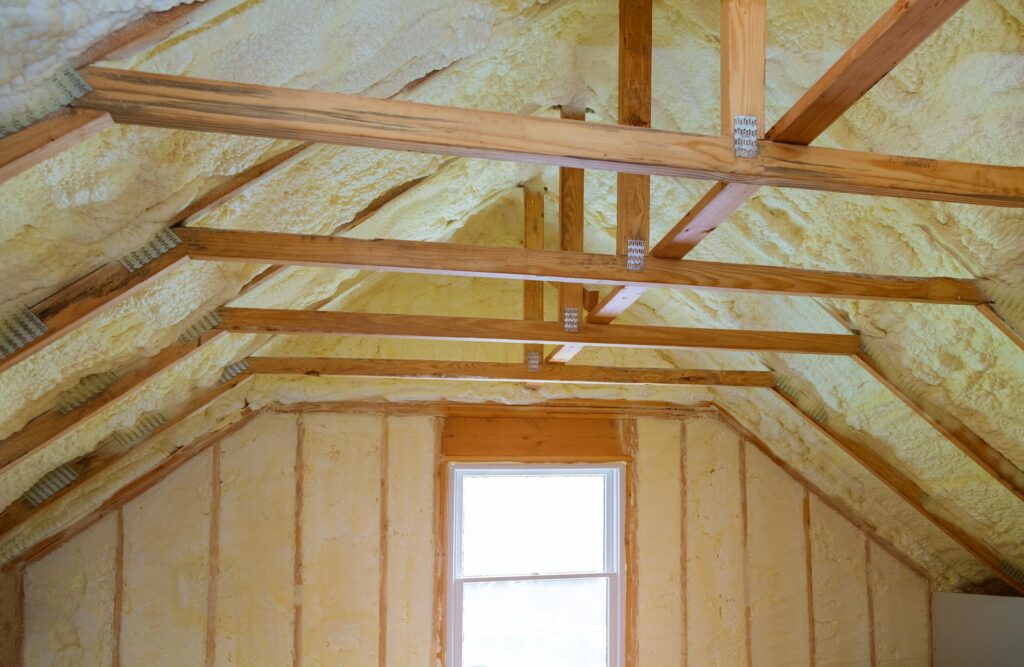Keeping your home cool in the summer and warm in the winter often leads to high energy bills. One important factor that many homeowners overlook is the quality of their insulation. Good insulation plays a critical role in maintaining consistent temperatures within your home, which can significantly lower your heating and cooling costs.
How Good Insulation Works to Save Energy
Good insulation works by creating a barrier that reduces the flow of heat into and out of our homes. During the winter, it keeps the warm air inside, making it easier and more efficient to heat our living spaces. In the summer, it prevents hot air from entering, which means our air conditioning systems don’t have to work as hard to keep our home cool.
Insulation materials are designed to trap air or other gases within small cells, which slows the movement of heat. This process is known as thermal resistance and is measured by an R-value. The higher the R-value, the better the material insulates. Different areas of our home require different R-values; for example, attics usually need higher R-value insulation than walls.
By reducing heat transfer, good insulation helps our heating and cooling systems operate more efficiently. When less energy is needed to maintain a comfortable temperature, our energy bills decrease. Effective insulation also makes our home more environmentally friendly by reducing the overall energy consumption and lowering our carbon footprint. Properly installed insulation is key to maximizing these benefits and ensuring a comfortable living environment year-round.
Types of Insulation and Their Efficiency
There are several types of insulation available, each with its own set of advantages and efficiency levels. Understanding these options can help us select the best insulation for our specific needs.
1. Fiberglass Insulation:
Fiberglass insulation is made from fine strands of glass and is one of the most common types used in homes. It comes in batts or rolls and has a relatively high R-value. It’s effective for insulating walls, attics, and floors. Fiberglass is also resistant to water and fire, making it a durable choice.
2. Foam Board Insulation:
Made from rigid panels of polystyrene or polyurethane, foam board insulation provides high thermal resistance and is commonly used in walls and foundations. Foam boards are lightweight, easy to install, and boast a high R-value, making them excellent for areas that need strong thermal barriers.
3. Spray Foam Insulation:
This type of insulation creates a solid barrier by expanding into gaps and cracks when applied. It has a very high R-value and seals air leaks effectively. Spray foam can be used in hard-to-reach areas, providing excellent coverage and energy efficiency.
4. Cellulose Insulation:
Made from recycled paper products, cellulose insulation is an eco-friendly option. It is often blown into attics and walls, filling spaces tightly. Although its R-value is slightly lower than other types, its density helps block air movement, enhancing energy efficiency.
Selecting the right type of insulation depends on the specific areas of our home that need insulation, environmental considerations, and budget. Proper installation is essential to achieving the best performance from any insulation material.
The Benefits of Regular Air Duct Cleaning and Maintenance
Regular air duct cleaning and maintenance provide numerous benefits for our homes. Clean ducts help improve air quality by reducing the amount of dust, pollen, and other allergens circulating in the air. This is especially beneficial for family members with allergies or respiratory problems. Dust and debris in the ducts can easily be picked up by the airflow and spread, but regular cleaning removes these contaminants.
Maintaining our air ducts also boosts energy efficiency. When ducts are clean and free of blockages, our HVAC system doesn’t have to work as hard to circulate air. This reduces energy consumption and can significantly lower our utility bills. Blockages and leaks in the ducts force the system to use more energy to push air through, leading to higher costs.
Finally, regular maintenance extends the lifespan of our HVAC system. Clean ducts mean the system doesn’t have to operate under strain, reducing wear and tear on the components. This can save us money on repairs and replacements in the long run. Consistent air duct maintenance ensures our system runs smoothly, offering greater comfort and efficiency.
DIY Tips for Basic Air Duct Maintenance and When to Call the Professionals
We can take several steps to maintain our air ducts, but knowing when to call professionals is just as important. Here are some DIY tips:
1. Regular Dusting:
Regularly dust and clean around air vents to prevent dust from entering the ducts. This simple step helps keep air quality high.
2. Change Air Filters:
Replace air filters every few months or according to the manufacturer’s recommendations. Clean filters reduce the amount of dust and debris entering the ducts.
3. Inspect Ducts and Vents:
Periodically check ducts and vents for visible dust buildup, mold, or signs of pests. Early detection can prevent larger problems.
4. Seal Leaks:
Use duct tape or mastic sealant to fix small leaks or gaps in the ductwork. Sealing leaks helps maintain proper airflow and efficiency.
However, certain situations require professional help. If we notice significant mold growth, large amounts of dust or debris, or experience persistent problems with airflow and temperature control, it’s time to call in the professionals. Specialized tools and expertise are needed for thorough cleaning and addressing complex issues.
Conclusion
Taking care of our air ducts is essential for maintaining a healthy and efficient home. Understanding the signs that our ducts need maintenance and the benefits of cleaning them regularly can save us money and improve indoor air quality. Basic maintenance tasks like dusting and changing filters are easy to manage, but some situations require professional assistance to ensure everything is functioning properly.
Regular air duct maintenance not only makes our homes more comfortable but also helps our HVAC systems work efficiently. Clean ducts mean better air quality, lower energy bills, and fewer repairs. Keeping an eye on our air ducts and addressing issues promptly will help us enjoy a healthier living environment.
If you’re experiencing any of the issues mentioned or want to ensure your ducts are in great shape, contact All Thermo today. Our expert team is ready to provide top-notch air duct maintenance and cleaning services. Reach out to us now to schedule an inspection and enjoy a cleaner, more efficient home.

